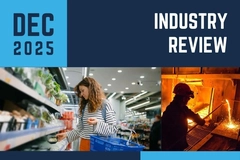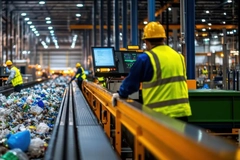Rethinking policy intervention: Nordic Council plastic report “borders on fantasy,” assert environment experts

25 Sep 2023 --- “Towards Ending Plastic Pollution by 2040” report, commissioned by the Nordic Council of Ministers for the Environment and Climate and developed by collaborative system designer Systemiq, presents a set of 15 global policy interventions toward ending plastic pollution by reducing annual mismanaged plastics by 90% and virgin plastic production by 30% by 2040 compared to 2019 levels.
But Packaging Insights’ conversation with Greenpeace and the Center for International Environmental Law (CIEL) provides an outlook into how the report misses the mark.
David Azoulay, environmental health program director at CIEL, emphasizes the limited scope of the report, which focuses solely on mismanaged plastic waste, not addressing the broader issue of plastic pollution. He points out that even if all the proposed measures were implemented, they would fall short of achieving a 1.5 degree Celsius scenario, the minimum required to mitigate climate impacts.
“This reveals a lack of ambition in the report’s objectives,” he states.
Graham Forbes, Greenpeace head of delegation to the Global Plastics Treaty negotiations, agrees and adds: “Even the Nordic Council of Ministers agrees that we cannot end plastic pollution without reducing plastic production, and the data is clear that we need much greater ambition than what’s presented in their report if we want to end this crisis.”
According to Forbes, the report falls short. “The speed and scale of production reduction do not match the scale of the plastics crisis. Their scenarios would still mean plastics representing 1.9 gross tonnage CO2 emissions per year by 2040, failing to meet the targets established by the Paris Climate Agreement.”
 The set of 15 global policy interventions presented by the Nordic Council report (Image credit: Systemiq).Call for supply-side measures
The set of 15 global policy interventions presented by the Nordic Council report (Image credit: Systemiq).Call for supply-side measures
The Nordic Council report aims to “provide a starting point for policy interventions and their required scope while recognizing that further changes to the plastic system are needed to fully address all aspects of plastic pollution.”
The document models two alternative scenarios of how the plastic system could evolve by 2040: Business-as-Usual Scenario shows the impact on plastic stocks and flows, virgin plastic production, mismanaged plastics, GHG emissions, financial costs and employment of continuing on the current trajectory of plastic consumption and waste management.
The Global Rules Scenario assumes that common global rules in the international, legally binding instrument would trigger far-reaching policy interventions across the plastic lifecycle, adopted across all geographies.
“The model underlying this report covers all geographies and all main economic sectors and plastic applications, including packaging, household and consumer goods, textiles, fishing and aquaculture, agriculture, construction, transportation and electronics,” clarifies the report.
“Meeting the target would require a 700% increase in recycling output relative to 2019 levels – this is highly optimistic, bordering on fantasy, as currently, only 9% of all plastic produced is recycled. This also only represents a delay in plastic being released into the environment. We cannot recycle our way out of this crisis,” comments Forbes.
According to Azoulay, the need of the hour is to establish supply-side measures, which the report fails to do.
“An interesting take away from the report is that even if you implement all those different measures [demand-side], you still get to a point where the amount of plastic we produce would continue to increase. And so, with that, would increase the amount of pollution that is suffered.”
Freezing production capacity
Azoulay highlights the ineffectiveness of demand-side measures alone, exemplified by the exponential growth in plastic production and pollution over the past 15 years, despite various attempts to curb consumption. He stresses the importance of curbing the production of problematic polymers and detoxifying the entire plastic supply chain.  Greenpeace head of delegation to the Global Plastics Treaty negotiations says the Nordic Council report falls short.
Greenpeace head of delegation to the Global Plastics Treaty negotiations says the Nordic Council report falls short.
The environmental expert suggests establishing a baseline, using data from 2019, to cap and reduce plastic production. He also proposes implementing a freeze on expanding production capacity to prevent further increases in plastic output. While acknowledging the need to address equity issues, he highlights the importance of different timelines for implementing these measures across countries.
“One of the measures that we believe will be necessary is to design a freeze to stop the continued expansion of the production capacity. We cannot deal with this issue only by thinking of it as increasing our waste management capacity.”
Eliminate emissions and toxicity
The CIEL environmental health program director affirms that there is a strong link between plastic pollution and GHG emissions. He criticizes the report for identifying the emissions issue but failing to address it adequately. Azoulay points out that even the best-case scenario outlined in the report would not align with sustainable emissions levels.
“The Systemiq report says that the measures they mentioned would lead to a 0% increase in emission versus 2019, under its best-case scenario. But we all know that the 2019 emission level in terms of climate is not sustainable and leads to the current burning and drowning we’re experiencing today. There is no doubt that we need to reduce those emissions.”
To address toxic chemicals and health hazards, Azoulay emphasizes the need to focus on plastic precursors and eliminate toxic materials early in production. He advocates for redesigning plastic products and a shift toward safer materials, which is covered in the report, but only partly and without consideration given to the actual toxicity of the plastic life cycle.
“If you want to get at the heart and eliminate the toxicity of the entire supply chain, you have to look at the plastic precursors: The monomers, polymers, plastic additives and processing agents that eventually make up plastic materials and products.”
 The CIEL environmental health program director affirms that there is a strong link between plastic pollution and GHG emissions.Challenges with circularity
The CIEL environmental health program director affirms that there is a strong link between plastic pollution and GHG emissions.Challenges with circularity
The conversation with Azoulay also touched on the concept of circular plastic, with him questioning its feasibility. Azoulay notes that true circularity for plastics is elusive and suggests that a reevaluation of circularity in the context of plastics is necessary.
“There is no such thing as circular plastic,” he states.
“Notwithstanding some of the gaps in the modeling that underpins the reports (in particular in relation to toxicity and climate impacts), the report demonstrates that the measures proposed are both necessary and highly insufficient.”
“A really ambitious approach requires that we not focus only on doing more of what we have been doing so far – trying to control the demand for plastic products – but also adopt innovative approaches such as controlling the supply of plastic precursor and material before they are even turned into plastic products,” he continues.
The critical perspective on the Global Plastic Treaty policy interventions underscores the need for more ambitious supply-side control measures, reducing plastic input and addressing toxic chemicals and emissions.
As the world grapples with the plastic pollution crisis, a paradigm shift in how industry and governments approach plastic production and consumption becomes imperative to achieve meaningful progress.
By Radhika Sikaria










